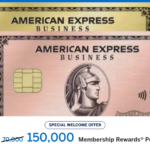Welcome to Miledom! Here’s your classic “start here” page
We’re all about miles – miles earned, redeemed, traversed. Why in that order? Every time you travel, you have many choices to make. Airlines, hotels, destinations. Class of travel, hotel star rating, activities. Even if you prefer backpacking and have no desire for luxury travel, “free” probably sounds pretty good.
The beginning of free travel
The greatest opportunities now revolve around earning miles through credit card signup bonuses, spend, and other promotions. It is easier than ever to amass quantities of miles and points to satisfy multiple business and first class flights and luxury hotel stays every year. For the most frugal who wouldn’t let a mile or point go to waste, economy flights are becoming easier to redeem, and requiring so few points, can be redeemed seemingly for perpetuity… You could also redeem points for cash back. Most premium cards nowadays offer signup bonuses high enough to redeem multiple business and first class flights!


So let’s first focus on earning miles that we can redeem to fund all of this. The hobby of travel hacking has been around for long, but has truly proliferated in the 21st century. Credit card issuers are ever hungrier for swipes, airlines prefer selling their miles inventory more than seats, and hotels want to secure your brand loyalty by offering ever more perks. They all cater to many points programs and ecosystems. Airline or hotel points can be used with the respective airline or hotel brands, but the most desirable transferrable points programs include American Express Membership Rewards (MR), Capital One Miles, Citi ThankYou Points (TYP), and Chase Ultimate Rewards (UR).
We should briefly note the classic comparison of points redemption value: points are best used with airline partners for maximum value. The highest cents per point (cpp) value is achieved by using transferrable points currencies right.
Transfer options and value
Programs offer different options and value – an airline or hotel cobranded card, such as Alaska’s or Marriott’s, accumulates only one rewards point currency. Some may offer cashback options: Chase Air Canada Aeroplan card offers an option to redeem 1 point for 1.25 cents. But the most attractive transferrable points currencies offer multiple ways to redeem. We have included a reasonable estimate of value possible to obtain by different options:
- Transfer to airline partners for long-haul business and first class flights (up to 20-30 cpp)
- Transfer to airline partners for long-haul economy class or ordinarily expensive short or monopolized routes (up to 10 cpp)
- Transfer to hotel partners (1-3 cpp)
- Redeem for general travel through card issuer portal (<1.5 cpp)
- Redeem for cash back (1 cpp)
- Redeem for merchandise, such as a toaster (<0.8 cpp)
In the canonical example, 15,000 points redeem an 11-hour business class flight from New York to Hawaii, or a toaster you could find on eBay for $10.
And if you don’t yet have so-called premium cards which accumulate these so-valued points, not to worry. A reasonable credit score above 650 should suffice. Many of these cards are even free, nearly free, under $100, or otherwise offer more value than their annual fee.
(Even if you’re new to the US or somewhere else, even without an SSN, ITIN or credit history, you can get started with premium cards.)
Stacking done right
Apart from credit cards, shopping portals offer miles or cash for shopping as usual on all your favorite websites through them. They might also offer bonuses or promotions for signing up for new services. The cashback generally stacks on top of other discounts or offers. New users may also qualify for bonuses such as $xx cashback after spend. Many airlines operate their own portals where you can earn miles rather than cash back, but earnings and valuations may differ or lead to scattered points balances. We like TopCashback as travel promotions are frequent and payouts easy. You may use our link to sign up with them and obtain a new user bonus of up to $35.


Stacking deals, promotions and spend can yield brilliant value. Here’s just one example: With the American Express Hilton Aspire Card, which ordinarily earns 34 Hilton points per dollar on spend at Hilton properties (14x from card category bonus and 20x from the included Diamond status). Hilton has frequent promotions, such as the triple (base) points promotion, during which you could stack all of the following:
- 54 points per dollar from card spend and Hilton bonus
- Miles or cash back (say, 12%) on spend amount through a shopping portal
- Get $200 back from the semi-annual Hilton Resort Credit
- Redeem an Amex offer such as the recent “Spend $200, get $80 back” at Hilton properties
For $200 spend on a Hilton stay, you would get: 10,800 Hilton points (~$50 value), 12% cash back ($24), plus $200 back and yet a further $80 back. In other words, a free Hilton stay with lounge access, breakfast, possible suite upgrade and net profit of $154.
Which card to start with, then?
(If you liked that Hilton example, you may follow through to our application link for Amex Hilton Aspire. The current signup bonus is up to 180,000 Hilton points.)
We will introduce multiple cards throughout this journey. Briefly, a good generalist card offers value in multiple ways. A reasonable annual fee, no foreign transaction fees, good bonus points categories and easy award redemption come to mind. Airport fast track, lounge access, and travel and car rental insurances are easy to get used to. We’ve been happy with American Express and for an easy generalist card would recommend to apply for the American Express Green Card. The Green Amex has a $150 annual fee, offers a nice signup bonus, 3x bonus points on Travel, Transit, and Dining, $189 CLEAR Plus Credit, $100 LoungeBuddy Credit, no foreign transaction fees, and hundreds of Amex Offers. We estimate its first-year value at $950 which includes the signup bonus. If you instead apply for the Amex Platinum you’ll get first-year value exceeding $1800 and a list of benefits and credits much too long to delve into here. It remains a top choice for a premium travel card, and we’ll be covering more in another article.




